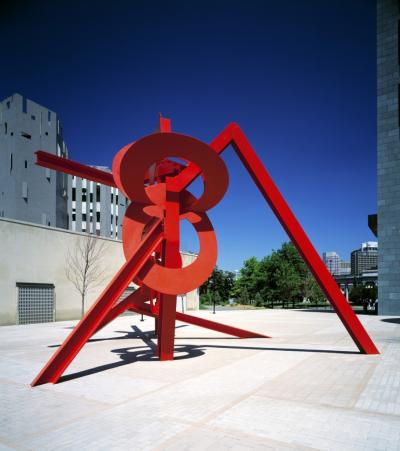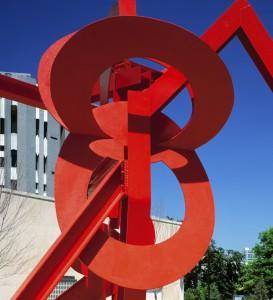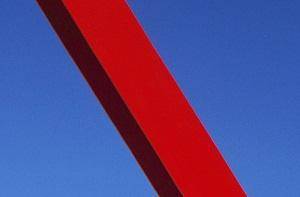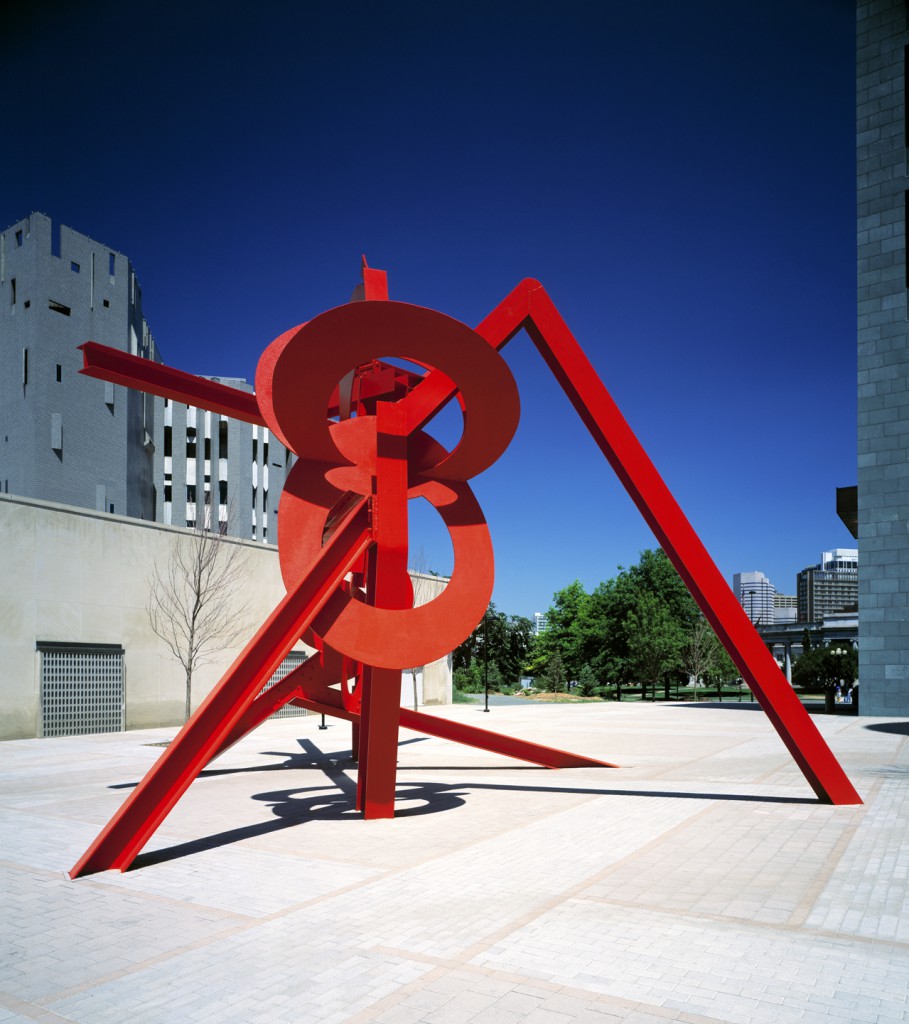Using Mark di Suvero’s sculpture Lao Tzu as an example, students will learn about the important considerations that must be kept in mind when designing site-specific sculptures. Students will then choose a space and design a sculpture for that space. Once their design is complete, students will explain to, either orally or in a written proposal, why their sculpture should be constructed and how it fits within their chosen space.
Students will be able to:
- explain how Lao Tzu was designed specifically for its space;
- identify what types of characteristics sculptures should and should not have when placed in specific spaces;
- design a sculpture for a specific space chosen by the class; and
- justify aloud or in a written proposal why their sculpture should be constructed at their school and how it fits a specific space.
Lesson
Day 1
- Display the image of di Suvero’s Lao Tzu and ask the students for their thoughts on the sculpture. Have them brainstorm ideas on how big they think the sculpture might be and how it may have been constructed. Why do they think this sculpture is outside? What might change if it were inside?
- Using the About the Art section, share some background information about the artist and explain his artistic process for creating sculptures. Focus on how di Suvero creates sculptures for specific spaces. Di Suvero attempts to engage viewers with his sculptures, saying, “I believe that certain structures have a certain resonance for people.” Have students reflect on how the sculpture is suited to the space that it’s in. How does the red color look against the sky and the grey concrete? Is the large size of the sculpture important? What might it be like if the sculpture were small? How do the shadows affect the piece?
- Ask the students: If you were to design a sculpture for our school, what would it look like and where would you want it to be located? Brainstorm as a class different locations for a sculpture. Examples of locations include the school entrance, library, cafeteria, roof, playground, etc.
- Have the students choose one space from their brainstorm and discuss the characteristics of that space. They should pay careful attention to the type of space they choose and what kinds of sculptures would be fitting for it. For example, if the sculpture was outside on the playground, it would have to survive different types of weather and shouldn’t have elements that will be ruined in rain or cold. If the sculpture was in the library it shouldn’t have elements that make noise. Create a list of important characteristics that a sculpture should and shouldn’t have, given the characteristics of the chosen space.
- Go to the location the students chose and have them sketch a sculpture that they would put in this space. As the students are working, remind them of the different characteristics their sculptures should and should not have.
Day 2
- Give students time to complete their sketches for their school sculpture.
- If working with older students, invite them to write mock letters to the school, principal, or school board justifying why their sculpture should be built and requesting money and permission to build it. In the letter, have the students explain how their sculpture is suited to the location they chose.
- If working with younger students, have them present their drawings to the class and explain why they think it would be a fun sculpture to have at school.
Materials
- Paper or journals and lapboards
- Assorted pencils, pens, or markers
- About the Art section on Lao Tzu
- One color copy of the sculpture for every four students, or the ability to project the image onto a wall or screen
Standards
- Visual Arts
- Invent and Discover to Create
- Observe and Learn to Comprehend
- Relate and Connect to Transfer
- Envision and Critique to Reflect
- Language Arts
- Oral Expression and Listening
- Research and Reasoning
- Writing and Composition
- Reading for All Purposes
- Collaboration
- Critical Thinking & Reasoning
- Information Literacy
- Invention
- Self-Direction

Lao Tzu
Mark di Suvero
1991
Height: 29.5 ft. Width: 16.5 ft. Depth: 36.5 ft.
Funds from NBT Foundation, Jan and Frederick Mayer by exchange, and friends of modern & contemporary art, 1996.11
Photograph © Denver Art Museum 2009. All Rights Reserved.
Mark di Suvero was born in China in 1933 to Italian parents who were serving as diplomats in Shanghai. He vividly recalls visiting the Forbidden City, the Imperial Palace complex located in the heart of Beijing, and marveling at the experience of space as at once infinite and comprehensible. When he was seven years old, di Suvero’s family moved to San Francisco where he dropped out of high school to explore the United States. After studying art at the University of California at Berkeley, di Suvero moved to New York in 1956 and did construction work to support himself while working on his art. Di Suvero started off creating sculptures out of wooden beams, metal pipes, old tires, and other discarded items. His materials would soon grow to I-beams, like those used in Lao Tzu, which are made of steel and typically used for support in houses.
In 1960, di Suvero was forced to quit his construction job after an on-site accident crushed his pelvis. This didn’t stop him from creating art, however. After using a wheelchair for the next decade, he began walking again with braces and crutches. Despite his limited mobility and the industrial qualities of his sculptures, di Suvero performs most of the work himself. “I do most of the cutting, welding, and crane work,” he says. The artist uses his crutch, several cranes, a cherry picker, and welding equipment that he operates himself to bring the sketches of his artworks to life.
Di Suvero moves directly from drawings of his ideas to the actual realization of his sculptures, with no three-dimensional models in between. “If it works in space on paper, it’ll work with I-beams,” he says. In fact, some have likened his sculptures, with their strong diagonal lines and looping forms, to drawings or “doodles” brought to life in space. Even though this sculpture is nearly 30 feet high, 36 feet long, and weighs 16.5 tons, di Suvero insists he does not make “monumental sculpture.” Instead, he aims to create sculptures that will activate the spaces, the structures, and the people around them. Di Suvero attempts to engage viewers with his sculptures, saying, “I believe that certain structures have a certain resonance for people.” Sonnet Hanson, DAM Master Teacher for Modern and Contemporary Art, describes Lao Tzu as “a jungle gym for the imagination—both for di Suvero, who animates space through strong but playful lines, and for viewers, who can make their own associations with the shapes, colors, line, weight of the sculpture and the space that it animates.”
Di Suvero names his sculptures after things he cares deeply about, drawing from his studies and interests in philosophy, poetry, music, dance, science, and art history. Some of his titles acknowledge people who inspire him, like Mother Theresa and jazz musician Charlie Parker. He named this sculpture after Lao Tzu, a Chinese philosopher from the 6th century BC whose writings are the foundation of Taoism (a centuries-old tradition that bases human experience on nature, vitality, and peace). But di Suvero is cautious about assigning specific meaning to his sculptures. “I try to keep them abstract,” he says. “The titles are just a handle.”
Details

Shapes
This sculpture includes circular shapes, strong lines, and sharp angles. Look for the interlocking arcs di Suvero uses to link the I-beams together.

Mobility
At the top of the structure, there is a mobile steel beam in the shape of an L that moves with the wind.

Color
According to di Suvero, the color was chosen to contrast the blue skies of Colorado.

Dynamics of Space
This sculpture is located in the plaza between the Denver Public Library and the North Building of the Denver Art Museum. Seeing the sculpture from different points of view—up close, far away, and at different angles—might make it seem like a completely different object. Notice the relationship between the sculpture and the buildings, people, and space around it. Also notice how the shadows cast by the sculpture play a roll in how it is seen.
Funding for object education resources provided by a grant from the Morgridge Family Foundation. Additional funding provided by the William Randolph Hearst Endowment for Education Programs, and Xcel Energy Foundation. We thank our colleagues at the University of Denver Morgridge College of Education.
The images on this page are intended for classroom use only and may not be reproduced for other reasons without the permission of the Denver Art Museum. This object may not currently be on display at the museum.







